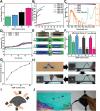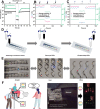Reprogrammable, Sustainable, and 3D-Printable Cellulose Hydroplastic
- PMID: 38803059
- PMCID: PMC11304289
- DOI: 10.1002/advs.202402390
Reprogrammable, Sustainable, and 3D-Printable Cellulose Hydroplastic
Abstract
Modern human societies are highly dependent on plastic materials, however, the bulk of them are non-renewable commodity plastics that cause pollution problems and consume large amounts of energy for their thermal processing activities. In this article, a sustainable cellulose hydroplastic material and its composites, that can be shaped repeatedly into various 2D/3D geometries using just water are introduced. In the wet state, their high flexibility and ductility make it conducive for the shaping to take place. In the ambient environment, the wet hydroplastic transits spontaneously into rigid materials with its intended shape in a short time of <30 min despite a thickness of hundreds of microns. They also possess humidity resistance and are structurally stable in highly humid environments. Given their excellent mechanical properties, geometry reprogrammability, bio-based, and biodegradable nature, cellulose hydroplastic poses as a sustainable alternative to traditional plastic materials and even "green" thermoplastics. This article also demonstrates the possibility of 3D-printing these hydroplastics and the potential of employing them in electronics applications. The demonstrated hydroshapable structural electronic components show capability in performing electronic functions, load-bearing ability and geometry versatility, which are attractive features for lightweight, customizable and geometry-unique electronic devices.
Keywords: 3D‐printing; cellulose; electronics; hydroplastic; sustainability.
© 2024 The Authors. Advanced Science published by Wiley‐VCH GmbH.
Conflict of interest statement
The authors declare no conflict of interest.
Figures





References
-
- Cheung W. M., Leong J. T., Vichare P., J Clean Prod 2017, 167, 759.
-
- Laurati M., Sotta P., Long D. R., Fillot L.‐A., Arbe A., Alegrìa A., Embs J. P., Unruh T., Schneider G. J., Colmenero J., Macromolecules 2012, 45, 1676.
Grants and funding
LinkOut - more resources
Full Text Sources
